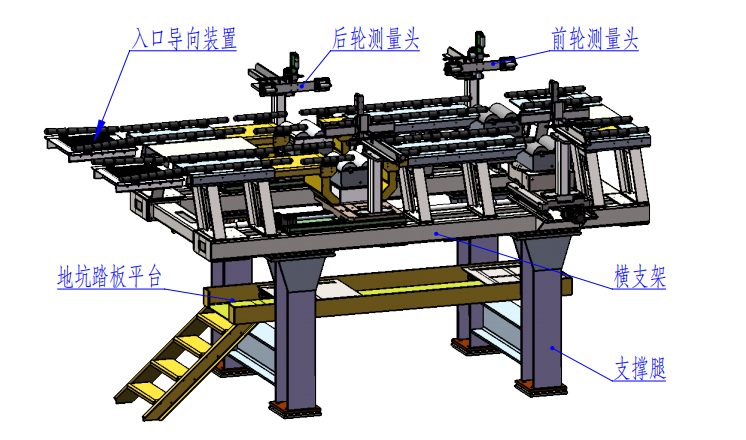Dynamic 4 wheel alignment manufacturers tell you what are the key angles of 4 wheel alignment:
① Wheel camber angle
Definition: The angle between the tire axis and the vertical line of the road when viewed from the front of the car is called the camber angle. The wheel tilting outward is positive, and the wheel tilting inward is negative.
Function: To prevent the wheels from tilting inwards due to deformation of the suspension system when the vehicle is fully loaded, to prevent partial damage to the tires and to relieve the load on the hub bearings. To reduce the distance from the vertical rotation plane connection address of the front tire to the intersection of the extension line of the kingpin axis and the road surface, thereby making the rotation easier.
② Kingpin inclination angle
Definition: When viewed from the front of the car, the angle between the steering axis and the vertical line of the road is called the kingpin inclination angle. The kingpin tilting inward is positive, and the kingpin tilting outward is negative.
Function: Makes the turn easier and turns the front tire to the rear, creating right-hand torque.

③ Kingpin caster angle
Definition: When viewed from the side of a car, the angle between the steering axis and the vertical line of the road is called the kingpin caster angle. The kingpin tilting backward is positive, and the kingpin tilting forward is negative.
Function: When the steering wheel is slightly deflected by an external force during driving, the castor will cause the wheel to turn to the reverse torque and automatically turn the wheel to the right, thus ensuring the reliability of the car's straight-line driving.
④ Toe angle
Definition: Looking down from the top of the car, the angle between the tire axis and the vertical axis of the car is called the toe angle. If the distance between the front edges of the two wheels is less than the distance between the rear edges, it is positive, otherwise it is negative. The angle between the two tire axes is called the total toe.
Function: Eliminate the adverse effects caused by wheel camber, relieve the working pressure of wheel hub bearing and the damage of tire.
⑤Thrust angle
The bisector of the total toe angle of the rear tire is called the torsion line. The angle between the geometric axis of the vehicle body and the torsion line is called the torsion angle. The absolute value sign requirement of the torsion angle is: when the torsion line is deflected to the left, the torsion angle is positive, otherwise it is negative.
⑥ Steering front angle
The difference between the turning angles of the two front tires when the wheels turn is called the front angle. Generally, the front angle of 20 degrees is used as the accurate measurement value.
⑦Inclusion angle
When viewed from the front of the car, the angle between the centerline of the kingpin and the axis of the wheel tire is called the tolerance angle. The nominal value is equivalent to the sum of the kingpin inclination angle and the wheel camber angle.
Related News
- How does the dynamic four wheel aligner avoid communication interference?
- Introduction to vehicle electrical inspection
- How to choose a good pass four wheel aligner
- What is the assembly line
- The important role of the through four wheel aligner
- The four main points of 3D laser four wheel aligner maintenance
- Working principle of electric chassis dynamometer
- Vehicle off-line comprehensive diagnostic equipment
- How to choose a good dynamic four wheel aligner
- Precautions for selecting a non-contact four-wheel aligner
- Analysis of the Function and Operation Process of Automobile 4-Wheel Alignment Instrument
- Things to note when purchasing a dynamic 4 wheel alignment instrument
- Analysis of summer maintenance items for 3D4 wheel alignment
- What are the application principles and advantages of 3D4 wheel alignment instrument?
- How to tell if a dynamic 4 wheel alignment has Bluetooth technology
- Why do large trucks need 4-wheel alignment?
- How to choose a good quality 4 wheel alignment instrument
- Analysis of installation issues of dynamic 4 wheel alignment
- Analysis of some uses of 4 wheel alignment
- Introduction to the reasonable use of dynamic 4-wheel alignment
